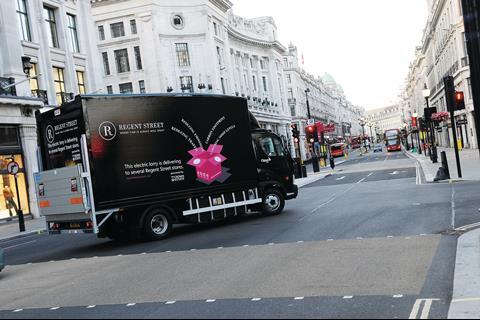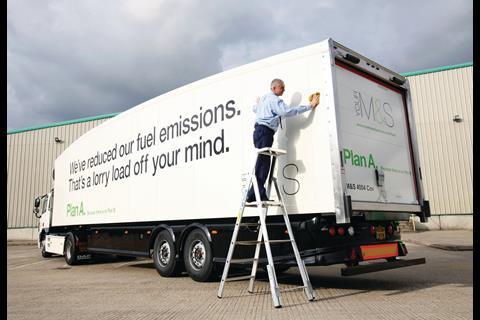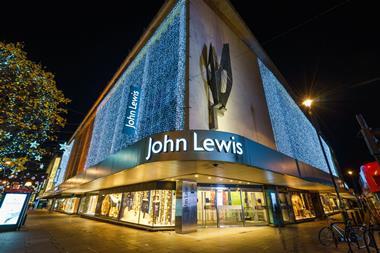Creating a more environmentally friendly supply chain can go hand in hand with reducing costs, as retailers find new ways to drive efficiencies. Matthew Valentine looks at some innovative approaches.
If there is one area where retailers have been almost universally keen to adopt environmentally friendly practices, it is in their supply chains. The reason could not be simpler: improving efficiency to reduce environmental impact also reduces costs.
More efficient vehicles, through modern engines or improved aerodynamics, or more efficient route planning, mean less money is spent on fuel. And Richard Wilding, professor of supply chain strategy at Cranfield School of Management, points out that fuel is only one of many resources used in the retail supply chain. Time, people, materials, facilities, energy and money are among the other resources employed, and all must be managed to ensure optimum efficiency and minimal environmental impact.
“Water is becoming a really big issue, for example,” says Wilding. Regional distribution centres may increasingly capture rainwater to avoid problems such as the drought that threatened much of the southeast of England earlier in 2012, he says. The water can be used for flushing toilets and cleaning vehicles.
As energy costs rise, wind turbines and solar panels to power distribution facilities will also become more attractive to retailers, despite the upfront cost, suggests Wilding. And some retailers might go even further. Green roofs provide excellent insulation to make warehouses cheaper to heat or cool. If used on stores too, these earth-covered roof spaces could be used to grow fresh produce at the point of sale, he says – adding that supermarket chains are actively discussing that idea.
More efficient distribution centres are certainly on the cards at discounter Poundland. The retailer has a temporary distribution centre to provide products for its stores in the Southeast. But rapid expansion – Poundland is currently opening more than 60 new stores every year – means a larger facility will be needed within two or three years, says supply chain director Andy Monk.

“We are thinking about planning a new distribution centre, and if we build that, one of the things on the agenda is that it has to be environmentally friendly – how we make it carbon neutral and get the lowest energy consumption and so forth. We will build all of those things in as and when the time is right,” says Monk.
Self-sufficient
But with the firm control on costs that Poundland exerts, environmental efficiencies must pay for themselves, adds Monk: “We are looking at ‘re-lamping’ one of our warehouses and putting more efficient lights in. I would say that cost savings are a major motivation for us, and if something is environmentally friendly too, that’s even better.”
Poundland is in a good position to build in environmental efficiencies as it develops distribution centres. But more mature retailers which have to retro-fit green elements might find it harder to justify the costs involved, says Monk.
However, when it comes to modifications to the vehicle fleet, the return on investment can be far quicker given the high cost of fuel. For longer journeys, Poundland has a fleet of double-decker trucks that can fit nearly double the number of pallets carried by conventional trailers.
“If we push out, say, 30 double-deck trailers a night, that would have been 60 if we had stayed with the conventional trailers,” says Monk. “We have just introduced some of what we are calling ‘urban double decks’, 33 ft trailers that again are double-decked, for store deliveries. A lot of our stores are high street based, so we can’t get a 40 or 45 ft trailer in. We’ve got five 33 ft double-deck trailers but, again, it lets us get 30-odd pallets on what would be a 16-pallet trailer.” Targets have been tightened for the planning department, demanding that less space be wasted by packing the trailers more effectively. Over the last 18 months, Poundland has increased the number of pallets carried on its trailers by about 8%.
Collaboration and consolidation are increasingly popular. Monk confirms that, if economically viable, Poundland would consider becoming involved in consolidation schemes such as the one that operates for stores in London’s Regent Street, if they were launched in other towns and cities.
The scheme, run by Clipper Logistics Group for The Crown Estate, recently won the Hermes Retail Week Green Supply Chain Initiative of the Year award. It uses a consolidation centre in Enfield to organise and dispatch goods to Regent Street stores using an electric vehicle that produces no tailpipe emissions. The Crown Estate development manager Peter Bourne says it came about because of a desire by the property group to widen the pavements in the West End. Vital to that aim was to achieve a reduction in vehicle traffic.
“To our surprise, when we had some surveys done, they found that actually more than 25% of traffic was goods vehicles,” says Bourne. Among the 22 shops that use the service, vehicle visits have fallen by 80%. “It is a phenomenal reduction. Even if you were using diesel vehicles it would be good news on emissions. With an electric vehicle they are virtually zero,” he adds.
The scheme has proved popular with store managers. Because the vehicle is only delivering to Regent Street stores the driver can make relatively accurate predictions about when he will arrive at each location. And retailers new to the UK, of which the street has a growing number, can benefit from a ready-made logistics network.
With such an array of areas that can be trimmed or realigned to improve environmental efficiencies, retailers need to explore what best applies to their supply chains. But it can certainly be worth the effort.
Sustainable ambition
Marks & Spencer’s eco and ethical Plan A commits the company to becoming the most sustainable big retailer in the market by 2015.
The retailer says its UK and Republic of Ireland distribution systems have now achieved carbon neutral status. New software, better planning and more efficient vehicles have reduced fuel usage by between 28% and 30% per product, depending on the category.
M&S has upgraded all engines in its fleet, reducing emissions, and introduced more than 400 teardrop trailers, which are more aerodynamically efficient.
They reduce fuel consumption by 10% and increase capacity by the same amount.
M&S has increased energy efficiency in its warehouses by an average of 33% compared with 2006/07.
Chilling and refrigeration technologies have also been upgraded in all distribution facilities.
Trials are under way to assess dual fuel diesel and compressed gas vehicles, and hydrogen fuel-cell powered forklift trucks.
Improving the service
Pall-Ex has operated a nominated carrier service for Asda for five years. It collects freight from ambient grocery and general merchandise suppliers then consolidates it at a central hub before delivering it to the grocer’s distribution centres in Lutterworth and Doncaster.
Having one point of contact for multiple suppliers makes it easier to track deliveries, and reduces administration and vehicle journeys because each truck carries more. Pall-Ex calculates that it reduced the distance travelled by 340,000 miles in 2011. Suppliers saved money too, by reducing the locations they delivered to, according to Pall-Ex.
Asda primary development manager for central supply Andrew Robinson says: “Pall-Ex helps us to get products to our stores quickly and efficiently, which is key to maintaining availability and maximising sales. We’re provided with a full end-to-end service from collection, to load consolidation and booking into the Asda depot. This has helped to offer cost savings and service improvements to our suppliers.”




























No comments yet